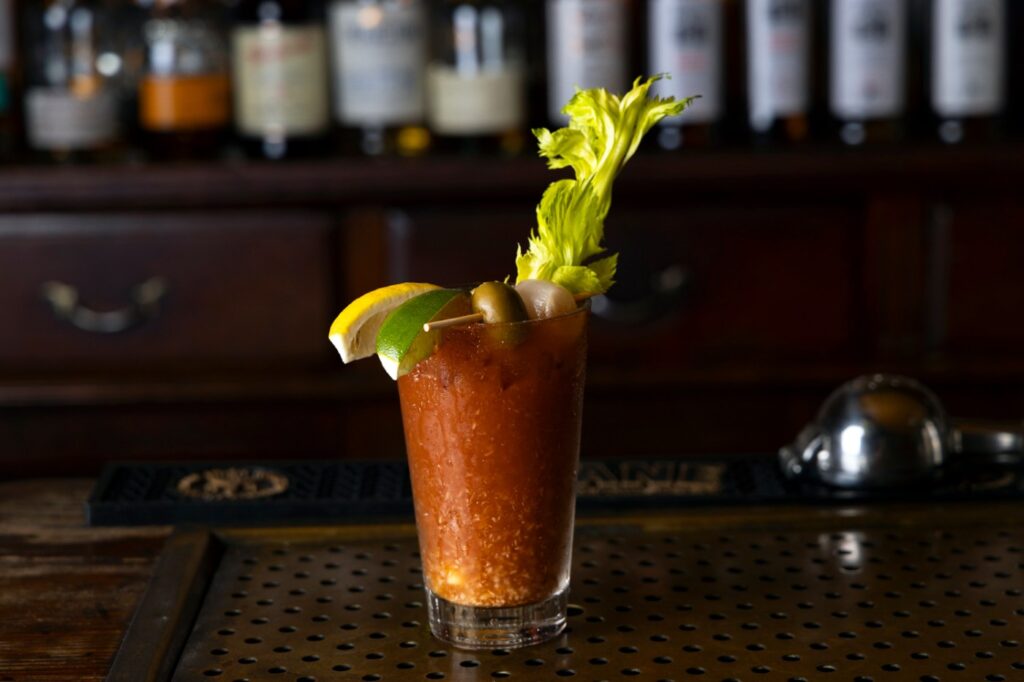By Eric Asimov, The New York Times
—
When we stopped in for dinner last spring at the Wren, a wonderful new gastro pub in Baltimore, my wife, Deborah, ordered a Bloody Mary. The bartender looked surprised, but recovered quickly and asked, “Gin or vodka?”
Now it was my turn to be surprised. Gin in a Bloody Mary? Never heard of it.
The bartender proceeded to mix up a drink (with vodka) that Deborah called the most exquisite Bloody Mary she’d ever had. It was superb—the spicy jabs from the Tabasco and horseradish, the sweet umami of the tomato juice, and the tart shock of the lemon juice playing off one another with balletic grace. I put his creation up there with my other favorite Bloody Mary, from Cafe Mutton in Hudson, New York.
I rarely drink Bloody Marys. I don’t drink cocktails much at all, as I prefer to devote what capacity I have for alcoholic beverages to wine. But at the proper moment, I do love a Bloody Mary and put it up there with the great cocktails of the world.
—
Cocktail culture hasn’t always agreed. Many skilled bartenders seem to scorn the Bloody Mary, regarding it as unserious and lightweight, just as many in the food world loathe brunch—the meal most often associated with the Bloody Mary—or wine people ridicule Sancerre, seeing it as a fallback order for people who know little about wine.
I want to stand up for the Bloody Mary, and for brunch and Sancerre, too. Brunch is a supremely painless solution for fulfilling certain social obligations. Sancerre can be superb and, after all, people are better off with good Sancerre than, say, pinot grigio. And the Bloody Mary is a great drink and ought to be recognized as one.
—
Cocktail writers don’t always feel this way.
*“The Bartender’s Book,”* a 1951 guide, called it “a savage combination of tomato juice and vodka,” and David A. Embury, who wrote *“The Fine Art of Mixing Drinks,”* first published in 1948, described it as “strictly vile.”
Writers for The New York Times have had mixed feelings about the Bloody Mary. Craig Claiborne and Mimi Sheraton adored them. But Frank Bruni in 2010 called it “the pitiable hair of the shameful dog.”
Rosie Schaap blamed a childhood incident with a skunk and tomato juice for her aversion, and William L. Hamilton wrote, “vaguely nutritious because of the vegetable content, Bloody Marys were like multivitamins for WASPs.”
All three eventually came around to praising the drink, although I might raise an eyebrow at Hamilton, who tried to make a case for replacing the tomato juice with beet juice.
—
Robert Simonson, a cocktail historian who writes *The Mix*, was a late adopter himself thanks to the generally improved level of the cocktail, with superior components and more serious, skilled bar work.
Simonson suggested that bartenders don’t really disdain the Bloody Mary; they just are annoyed at having to make what is almost universally considered a brunch drink after hours.
“It’s a bit of work,” he said, “and they’ve probably put away that stuff as it’s a day-drinking drink.”
The link to brunch might also be a problem, Simonson said. “People either love brunch or have complete contempt for brunch, and they’re both right.”
—
Why is it so associated with brunch?
As Bruni suggested, the Bloody Mary is widely believed to be a hangover remedy. Why is this? Perhaps because tomato juice is nutritious, packed with vitamins and antioxidants, and the spiciness can induce a sweat, which, as people like to believe, rids the body of poisons.
I personally believe that nothing cures a hangover but time and willpower, but who am I to tell suffering souls they are wrong?
—
The origin of the Bloody Mary is murky, but many attribute it to Fernand Petiot, a barman at Harry’s New York Bar in Paris in the 1920s, who made good use of a new product: canned tomato juice.
As the story goes, Petiot was hired by King Cole Bar at the St. Regis in New York and wanted to make the drink, but it was almost impossible to find vodka in New York at that time. Instead, he made it with gin and rather than call it a Bloody Mary, which assaulted the genteel ears of the hotel owners, he named it the Red Snapper.
Vodka did not become widely available in the United States until after the early 1950s. The Bloody Mary became especially popular then as it was used to promote vodka as a spirit. (I guess the bartender at the Wren was not so out of line with his question about gin.)
—
The Bloody Mary screams out for variations.
– If made with tequila or mezcal, it’s called a Bloody Maria.
– Replace the tomato juice with beef broth and it’s a Bull Shot.
– My brother-in-law used to make them with Clamato juice, which, as I’ve learned, is a favorite of Canadians, who call the drink a Caesar.
—
I spoke to Adam Estes, who made my wife’s drink at the Wren in Baltimore. Estes, the bar manager there, said that what I had interpreted as surprise was in fact enthusiasm.
“I was actually excited,” he said. “It’s such a great drink, but I almost never get to make one of those.”
As you might guess, the Wren does not serve brunch.
Estes agreed with Simonson that bartenders in the evening don’t want to make Bloody Marys because they’re not prepared for it.
“It’s fallen out of fashion a bit because it feels like a heftier and older drink to a lot of younger people who are looking for lighter beverages,” he said. “It also didn’t help the drink when people started doing all the absurd garnishes, like perching a whole roast chicken on a glass.”
—
Ah, the garnishes.
A celery stalk seems perfect for stirring. Pickled onions or peppers seem proper. Pick one, but don’t turn the Bloody Mary into a salad bar, or worse.
“It’s really the most heavily garnished cocktail in the world,” Simonson said. “I’m from Wisconsin, overloading on the garnishes is a religion there.”
He mentioned Sobelman’s, a Milwaukee pub infamous for its flamboyant garnishes, which started as skewers of pickled vegetables and rapidly progressed to cheeses, sausages, cheeseburgers, slices of pizza and, yes, whole fried chickens, which will cost you $65 a drink.
Few things jar the delicate pretensions of the cocktail sophisticate so much as a drink with a chicken on top.
Can’t we just toss the poultry and other novelties and simply enjoy the craft and beauty of a beautifully made Bloody Mary?
—
“I’ve got some serious garnish fatigue just looking at them,” Estes said. “It’s fun, but hopefully we’ve reached peak kitsch Bloody Mary and are ready to get back to the savory, rich, wonderful, classic drink.”
—
## RECIPE: Bloody Mary
The Bloody Mary has evolved into an all-purpose cocktail that can be tailored to any taste. Swap out the spirits, vary the juice component or the spices, or go big on the garnishes, and you have a cocktail that can range from elegant to garish.
This classic version, from Adam Estes, the bar manager at the Wren in Baltimore, has a superb balance of flavors yet still leaves room for personal preference. Garnish as you wish—a celery stalk or a pickled onion is a great idea.
*Recipe from Adam Estes*
*Adapted by Eric Asimov and Cathy Lo*
*Yield: 1 serving*
*Total time: 10 minutes*
### Ingredients
– Ice
– 2 ounces vodka or gin
– 1/2 to 3/4 ounce fresh lemon juice, to taste
– 3 to 5 heavy dashes Worcestershire sauce, to taste
– 1 1/2 to 2 teaspoons prepared hot horseradish, to taste
– 4 dashes hot sauce (such as Tabasco)
– 2 dashes celery salt
– Fresh coarsely ground black pepper
– Splash of olive brine or pickle brine
– Tomato juice (such as Sacramento)
– Large pitted green olive (such as Gordal Queen), lemon wedge and lime wedge, to garnish
– Pickled onion and celery stalk (both optional), to garnish (see tip)
### Preparation
1. Fill a pint glass with ice to the top. Add vodka, lemon juice, Worcestershire sauce, horseradish, hot sauce, celery salt, pepper, and olive brine. Top off with tomato juice.
2. Pour into a shaker, shake to mix, then pour it all back into the pint glass. (You could also roll the shaker back and forth between your hands for a more gentle incorporation of flavors.)
3. Garnish with an olive, lemon and lime wedges, and, if desired, pickled onion and celery.
### Tip
Adam Estes suggests pickling your own onions, which is especially easy if you can find already peeled fresh pearl onions. Make a simple brine of salt, sugar, vinegar, and water, bring it to a boil and pour over the onions in a clean glass jar. Close the jar, refrigerate, and let pickle for 2 to 3 days, or more, tasting the onions occasionally until they’re pickled to your liking.
https://www.denverpost.com/2025/10/28/standing-up-for-the-beauty-of-a-good-bloody-mary/

